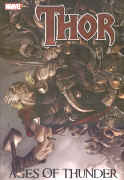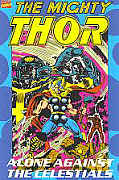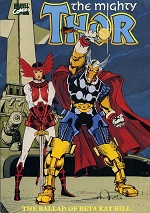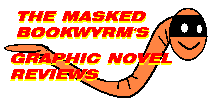 The
Masked Bookwyrm's Graphic Novel (& TPB) Reviews
The
Masked Bookwyrm's Graphic Novel (& TPB) Reviews
Thor (Page 2)
for a complete alphabetical list of ALL reviews start here
A - B - C - D - E - F - G - H - I - J - K - L - M - N - O - P - Q - R - S - T - U - V - W - X - Y - Z
Thor: Ages of Thunder (2009) 160 pages
 Written by Matt Fraction. Pencils by Patrick Zircher, Khari Evans, Clay Mann. Inked by Zircher, Victor Olazaba.
Written by Matt Fraction. Pencils by Patrick Zircher, Khari Evans, Clay Mann. Inked by Zircher, Victor Olazaba.
Colours: June Chung, Matt Milla, Paul Mounts, Jelena Kevic Djurdjevic. Letters: Chris Eliopoulos. Joe Caramagna. Editor: Warren Simons.
Reprinting: the one-shot specials Thor: Ages of Thunder, Thor: Reign of Blood, Thor: Man of War, Thor: God-Size (2008)
Rating: * * * 1/2 (out of 5)
Number of readings: 2
Reviewed November 17, 2009
Published by Marvel Comics
Thor, as a comic book character, is a kind of melting pot of influences. Sometimes the stories are just those of a super hero whose inspiration lies in Norse myth. Other times, the comic is more sword & sorcery based on ancient folk tales. Other times, there's a decided science fiction flavour. No one version of Thor is able to claim to be the true, definitive take on the character.
Thor: Ages of Thunder is very clearly rooted in the mythological and fantasy aspect. This TPB collects stories that were originally presented in various one-shot/specials...which was an odd presentation for them. Three of them -- Ages of Thunder, Reign of Blood and Man of War -- are all inter-linked, particularly Reign of Blood and Man of War. In fact, given that each double-sized issue is broken into two chapters, you almost wonder if it was originally planned for a six issue mini-series, then someone in Marvel's marketing department decided they might sell better pretending each was a stand alone special.
If so, one could well imagine a title for such a mini-series might've been Thor: Year One. Set eons ago, they tell tales of the Asgardian pantheon, with writer Matt Fraction borrowing some aspects from existing Norse myths (though liberally reinterpreted) mixed with other aspects that are original to Marvel's version of the character and to Fraction's take on him. The long ago origin of Marvel's Thor had it be that an unsuspecting earth man, Dr. Donald Blake, discovers he is in reality Thor, Norse God of Thunder, his human form, and accompanying amnesia, imposed upon him by All-father Odin to teach the young god humility. So Fraction's tale goes to the root of that, exploring what led up to such a drastic punishment.
What the stories also evoke is the Tales of Asgard back up stories Stan Lee and Jack Kirby used to run in the back of the old Thor comics (and which subsequent to this collection, Marvel reprinted in a Tales of Asgard mini-series). Though Fraction's take is a more gritty, adult version, with more brutal violence and racier aspects (Thor has a harem!)
In a way these don't fully evoke the Thor fans are used to reading about. Partly because they eschew the mix of styles for a strict historical/myth influence (gone are the Kirby-esque science fiction accoutrements that made Asgard as much an alien city as an ancient Norse fantasy). And sticking truer to the notion of mercurial gods and moral relativism common to ancient myths, these are a far cry from the more-or-less noble heroes Lee and Kirby envisioned. Odin and his gang are duplicitous, brutal, self-serving. As such, you don't necessarily feel you're reading about the Thor and Odin you know, but merely another interpretation based on the same source material.
And read that way...it's reasonably enjoyable.
Fraction does a decent job evoking a folk tale aspect, relying heavily on third person narration captions (even if he does sometimes slide into too modern sounding colloquialisms from time to time). There's also a surrealistic aspect, tipping its hat to the notion of cosmic cycles that earlier Thor comics have alluded to, in that even though the actions in one chapter seems to lead to the next, the scenes themselves are introduced as being the era of the "third Ragnarok", the "seventh Ragnarok", etc., as though history is supposed to be repeating itself in different millennia. Sometimes Fraction is taking inspiration from old legends, particularly at the beginning with a tale of a stone mason which, with some variation, was detailed in Wagner's classic opera, The Rhinegold*, and elsewhere. Later though, I think Fraction is drawing upon his own ideas and, perhaps significantly, the story seems to falter there a bit, the last issue (Man of War) imparticular thin on story, and more just a lot of hitting and fighting.
*(Wagner's operatic Ring of the Nibelung has been adapted multiple times to comics, both as straight adaptations and incorporated into the Thor comics in The Eternals Saga).
Overall, the plotting is a bit thin. The old Tales of Asgard stories were only about five pages. Here, each of Fraction's chapters are 18 pages...but feel like they often could've been five.
I don't mean that they necessarily feel stretched or dull, merely that when you get to the end, you realize the plotting was pretty thin.
The visuals go a long way to covering over that fact. Of the six chapters presented over the three issues, Patrick Zircher draws 3, Khari Evans draws 2, and Clay Mann does 1. And though not indistinguishable, they have sufficiently similar styles that the visuals are consistent -- and consistently strong, all artists capable of dramatic vistas, robust Asgardian halls, brooding, powerful men and voluptuous, scantily clad women (told you it could be a bit racy). The colours by the likes of June Chung and others add immeasurably to the sumptuous feel. And a few of the issues are presented in a kind of "wide screen" format, where most of the sequences are to be read left to right across a two page spread. If you're going to go for a fantasy milieu where the mood and atmosphere is as much a part of the storytelling as the plot and dialogue, these are the artists and colourists to do it.
So read as just a fairy tale, like a lavishly illustrated version of some old folk legend, these stories do the trick and get you turning the pages. However, they don't necessarily work on any deeper level.
As well, Thor himself is often a pretty minor character, only uttering a line or two here and there, showing up just long enough to smash a giant before receding back into the peripheries. If it's a character study (about his needing to be humbled)...we maybe need more of his character! As well, the amorality of the characters can make it a bit hard to get too involved with them. You can enjoy their machinations as you would reading an old folk tale, but you can't really sympathize. Thor is surly and bitter, disgusted by the antics of his fellow Asgardians -- as well he should be. Yet when Odin chastises Thor for his lack of humility and humanity, it's a bit like the kettle calling the pot black.
The fourth and final story reprinted here, "The Life and Death of the Executioner", was originally published in the one-shot/special, Thor: God-Size. And this one is more squarely about the familiar comic book Thor. Though still set within the mythological, Asgardian realm, this is the modern, more moral Thor, and the events arise out of previous comic book stories. Namely, an Asgardian villain-turned-hero, The Executioner, died nobly years ago (in Thor comics circa the 1980s). Yet suddenly Thor and others -- notably Balder and Loki (who is currently in the body of a woman?) -- find their memories of Skuurge seem to be altering, as if someone is messing with reality itself. So they set out on a quest to discover who, and why. Part of the gimmick here is that the 38 page story is broken into four chapters, illustrated by four different artists, and much of it coloured with a semi-painted look. The art is of mixed effectiveness, with Doug Braithwaite and Miguel Angel Sepulveda the most impressive, and Dan Brereton and Mike Allred more problematic. It's a decent enough tale and, as mentioned, is the one that most feels like a true Thor -- the comic book hero -- story. The original God-Size special also reprinted Thor #362, the issue in which the Executioner dies. I assume it's not included in this TPB collection, which is too bad, 'cause it's equally entertaining.
The result is a collection that, if you're looking for a nice Thor collection, doesn't quite hit the spot, with only the last story fitting that bill. But if you're looking for a lavishly illustrated story about gods and frost giants and Norse legends, it's an enjoyable -- if a bit thin -- page turner.
This review is based on the original, individually published specials.
Thor: Alone Against the Celestials 1992 (SC TPB) 64 pages
 Written by Tom DeFalco. Pencils by Ron Frenz. Inks by Brett Breeding.
Written by Tom DeFalco. Pencils by Ron Frenz. Inks by Brett Breeding.
Colours: various. Letters: John Workman. Editor: Ralph Macchio.
Reprinting: Thor (1st series) #387-389 (1988) - with covers
Rating: * * * * (out of 5)
Number of readings: 2
Published by Marvel Comics
The mighty Thor -- norse God and super hero -- accidentally crashes on the
planet Pangoria -- a pirate planet ruled over by a ruthless despot. But that
turns out not to be the problem. Instead Thor discovers the planet has been
judged by an enigmatic race of cosmic giants, the Celestials, and, having been
found wanting, it is slated for destruction. Thor sets out to save the world,
but even his might is nigh useless against a kilometre high being -- a being
he can barely get to notice his existence, let alone defeat.
Alone Against the Celestials is an enjoyable enough adventure,
benefitting from the very awesomeness of its cosmic adversaries (who had,
apparently, already appeared in a Thor story years earlier and subsequently collected as Thor: The Eternals Saga). There's more than
a little sense that writer Tom DeFalco is trying to evoke some of the cosmic
grandeur, and the ineffability of the universe, that Lee and Kirby did in
their classic Coming of Galactus story, decades earlier. The unknowable
celestials aren't bad guys in the strictest sense of the term...in fact, as
beings, they seem to exist almost wholly outside Thor's ability to comprehend
(and he's a demigod!) Various abstract ideas are tossed around, like Thor
wondering if the Celestials exist on such a separate level of reality that
they can be in more than one place at once. Though there's plenty of action,
it manages to seem like more than a simple, run-of-the-mill slugfest, and the
sequence where Thor enters a celestial's body is effectively head trippy.
At first blush, having Thor defend a planet whose inhabitants don't
entirely seem deserving of his help seems a curious narrative choice (though
there are good Pangorians, like a woman who befriends Thor). But that becomes
its own interesting character point, as Thor is so committed to his code of
honour, and defending the defenseless, that he will risk his very life
(knowing the celestials are more powerful than him) to defend even this
disreputable world.
The art by Ron Frenz and Brett Breeding is serviceable enough, and part of
the appeal when reading an older TPB is an aspect of nostalgia. There are no
computer tricks, or computer lettering, and the colour is single tone, but
nicely presented on crisp, white paper. It's refreshingly unpretentious art
(nicely contrasting with a plot that is a little pretentious). At first glance,
Frenz's style is more than a little reminiscent of John Buscema, the old
master who used to draw Thor for a spell. Though Frenz isn't quite on Buscema's level. Still, the evocation of other artists (including some decidedly Jack
Kirby-esque touches) is enormously appealing.
And just as Frenz is a decent artist, evoking, but falling short of, older
artists, so writer DeFalco presents an interesting, ambitious story, but where
the dialogue and characterization is more serviceable than exceptional. Even
Thor's speech patterns seem oddly half-hearted -- sometimes he speaks in his
patented "thee"s and "thou"s, and sometimes he doesn't so much. As well,
though DeFalco nicely tries to capture Thor's do or die determination,
unflinchingly throwing himself into a fight he doesn't for a minute think he
can win, in other ways DeFalco's presentation of the character is kind of
vague, lacking the dimension some earlier writers were able to bring to the
character. Put another way, if you weren't already a fan, or at least familiar
with the character, I'm not sure this would make you rush out and buy more.
Still, all in all, this is an enjoyable enough page turner for its 64
pages, benefitting from the genuine cosmic grandeur of its plot. The original
issues have been edited slightly to fit them into the page count, but not so
that it noticeably affects this story (I'm guessing the missing pages were
probably cutaways to sub-plots unrelated to this story).
Thor: The Ballad of Beta Ray Bill 1989 (HC & SC TPB) 88 pages
 Written and illustrated by Walter Simonson.
Written and illustrated by Walter Simonson.
Colour: various. Letters: John Workman, Jr.
Reprinting: Thor (1st series) #337-340
Rating: * * * (out of 5)
Number of readings: 1
Reviewed: Aug, 2015
Published by Marvel Comics
This four-part story marked a bit of milestone in Thor, and is interesting to consider (as I'm wont to do) in light of trends in comics -- namely, repeated patterns that emerge when new creative hands take over the reigns.
Because this marked Walter Simonson's assumption of the Thor comics -- Simonson who, as an artist, had drawn the occasional Thor comic in the past, but now took full control as a writer-artist and whose long run would prove popular with fans (even leading to a series of sequential Thor Visionaries TPBs collecting his entire tenure). So there is some re-setting of pieces on the board, which is not uncommon with such changing-of-the-guard stories. There's some arbitrary changes to the Thor mythology such as Thor dropping his Don Blake alter ego (Blake had long been a peripheral identity, but had nonetheless been part of the character since the 1960s) and Simonson kicks off his run by introducing his own, brand new character -- Beta Ray Bill.
Bill's a character that has continued to bounce around Thor comics and the Marvel U, including getting a mini-series or two -- but I'm not sure ever really took off the way Simonson probably hoped. A bizarrely goat-faced alien, he's a cross between Rom, Spaceknight (the Marvel Comics version about an alien who sacrifices his humanity to become a freakish warrior to protect his people from extraterrestrial conquerors) and Thor himself with, possibly, a visual design meant to evoke Cerebus the Aardvark. Although despite getting the cover, it should be noted Thor still remains a principle character in these proceedings.
The story is that Beta Ray Bill arrives on earth, mistaking Thor for the demons that are pursuing his people. After a big fight, Bill gets it into his head that Thor's hammer is the weapon he needs to protect his people -- and Thor's dad, all-father Odin, agrees to a winner-take-all bout between them, resulting -- after some complications -- in Bill becoming an ersatz Thor. Eventually Bill and Thor team up (along with the Lady Sif) and the three head off to battle the demons together.
Now I'll admit, I'm a bit mixed on Simonson in general -- I say that up-front because a lot readers love his stuff, so my review has to be considered in that context. Although I like aspects of his art, which is robust and dynamic and full of verve -- I also find the very stylized-ness of it can make it a bit hard to follow for me, particularly during fights and battles, where there can be a lot of lines and explosive effects, and even the figures can get confusing. And similarly, I find there's just a lack of warmth to his faces -- maybe it's a lack of shadow, maybe it's that aforementioned stylized-ness (or too many long shots) but I tend not to be as emotionally connected to his characters as I am in other comics. Likewise, though his writing is certainly fine, with perfectly good dialogue, it also doesn't tend to involve me in the characters. Simonson's Thor coming across as a fairly bland, slightly-empty helmet, as opposed to the more passionate, emotionally compelling Thor others have written (though, to be fair, there are also plenty of Thor writers who write him with even less personality than does Simonson).
Simonson was also, apparently, heavily into Norse mythology (some Thor scribes have been, some haven't) and maybe part of my ambivalence might be that Simonson is into the Old School machismo one associates with those old tales (I'm also reminded of his Starslammers graphic novel). So the story is built around various fights, and Thor and Bill developing a bit of bro-mance with each other (even the fact that Thor and Lady Sif have broken up -- although a plot point introduced by a previous writer -- suggests a comic wanting to get away from any of that sissy/mushy stuff). Again, none of this is out of keeping with Thor -- or comics in general -- but I'm just trying to articulate why, maybe, I wasn't that enraptured.
The plot itself, in a way, is strangely thin. Or rather, by the end it can seem like the main point was simply to introduce Beta Ray Bill, rather than his introduction was a by-product of the tale. When Thor, Bill, and Sif finally go off to battle the demons that started all this, it's actually just in the final issue and is, again, mainly just a lot of fighting. And though the danger is thwarted, we never really learn anything about the demons.
Throughout the issues are also a few sub-plots that are teased along -- including cutaways to another demonic menace that one might assume relates to the Bill demons, but doesn't. Instead it foreshadows Simonson's well-regarded Ragnarok epic a few issues down the line (which I did like). But though sometimes reading an old story with unresolved sub-plots can be sort of fun (immersing you in the long ago mythology) equally it can just feel like a lot pages are wasted on scenes that don't go anywhere in this TPB.
Ultimately, I'll admit a certain ambivalence toward this collection -- both a reflection of my mixed feelings toward Simonson, my current mental state (finding great comics few and far between at the moment), as much as anything wrong with the story itself. But it's also a perfectly decent sample/intro to Simonson's long run on the comic and so worth a look-in for those curious, but not yet sure if you want to invest in the Thor Visionaries TPBs.
